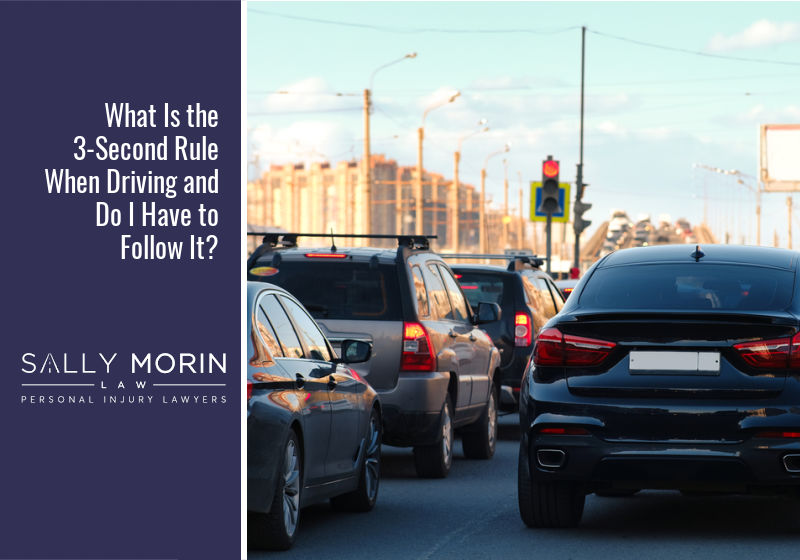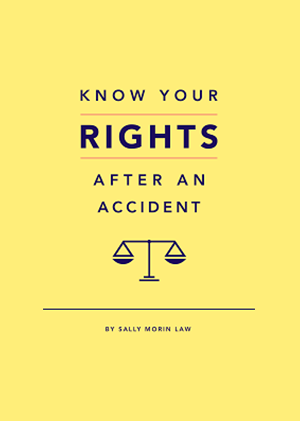Please be advised that the following topic is for informational purposes only and not a legal matter currently handled by our firm. If you have a serious injury claim and need legal representation, please contact us, but if need more information regarding this particular topic, you can contact your local Bar Association for a referral to an attorney who may be able to address your inquiry in more detail.
Anyone who drives in California has probably heard of the three-second rule when driving. But do you have to follow it? Driving instructors teach it and parents caution their teen drivers to, “Leave three seconds between yourself and the car in front of you.”
In simple terms, this means you should be able to count, “one, one-thousand, two, one-thousand, three, one-thousand” before you would rear-end the vehicle in front of you. Of course, the goal is to leave enough space that you wouldn’t rear-end someone!
Have you ever wondered whether this is just a general guideline or is actually the law in California? Great question. Let’s clear up what the three-second rule is and what it means for California drivers.
Understanding The 3-Second Rule When Driving
First, let’s look at why the three-second rule exists: It’s a mathematical fact. The three-second rule is based on the concept that braking distance is directly related to traveling speed. The faster a vehicle is moving, the longer it takes the driver to come to a complete stop.
Your stopping distance is equal to your reaction distance plus your braking distance. If you double your speed, you quadruple the distance it takes to stop.
When you abide by the three-second rule, you’ll usually avoid hitting a car traveling in front of you in most ordinary low-speed traveling situations. However, this doesn’t apply to high-speed highway driving, where it can take five to ten seconds to come to a complete stop.
To see if you’re following the three-second rule when driving, try this test on a low-speed road at a time when road conditions are safe to do so.
- When a car is traveling directly in front of you, locate a stationary object along the side of the road, like a traffic sign or street light.
- As the car in front of you passes the object, count how many seconds it takes you to pass the same object.
- If you reach the object before counting to three, you’re traveling too closely.
Is the 3-Second Rule a California Law?
The California driver’s manual refers to the three-second rule when driving by saying, “Leave three seconds of space (three-second rule) between you and the vehicle ahead of you. Make sure you can stop safely if you need to.”
However, the three-second rule isn’t a law. Rather, it’s a helpful guideline that could prevent a car accident if you keep it in mind and drive carefully.
California law requires you to maintain a safe traveling distance from the car in front of you regardless of how many seconds it takes to stop. Drivers should abide by speed limits and not follow other vehicles more closely than is “reasonable and prudent,” in the language of the law.
Always adjust your speed according to traffic and roadway conditions. If you rear-end someone after skidding in heavy rain and say, “Hey, I was just following the three-second rule,” it’s not a valid legal defense.
Tips for Using the 3-Second Rule While Driving
Stay safe on the roads by using the three-second rule as a guideline. Incorporate it into an overall strategy of defensive driving by leaving a safety cushion of space around your vehicle.
- Don’t tailgate. If someone tailgates you, increase your following distance in case the tailgater does something unexpected.
- When traveling at high speeds or in bad weather, increase your following distance.
- When traveling near a large vehicle like a semi-trailer, increase the space between your vehicle and theirs.
- Senior drivers and those with health/mobility issues can lower their risk of accidents by increasing their following speed and giving themselves more reaction time.
If you were in a traffic accident and have questions about the three-second rule, ask a qualified California car accident lawyer. At Sally Morin Personal Injury Lawyers, we have the experience to review your circumstances and help you understand how California’s driving laws apply to your case.
We Handle Your Accident Claim So You Can Focus On Your Life
After your accident, contact the attorney team at Sally Morin Personal Injury Lawyers. We handle many areas of personal injury law, including accidents related to the three-second rule when driving. We believe you should be able to focus on recovering from your accident while we handle the legal details. Call 877-380-8852 today for a free case evaluation.











